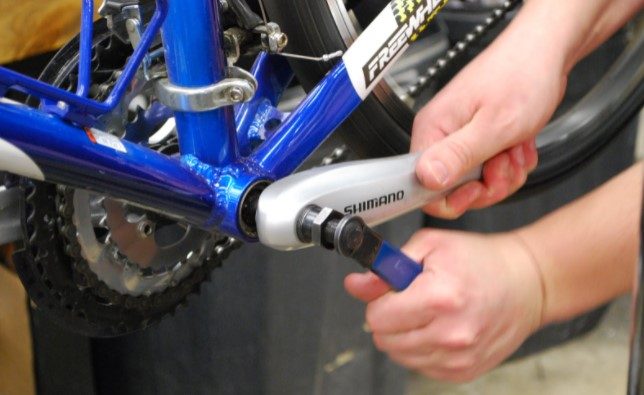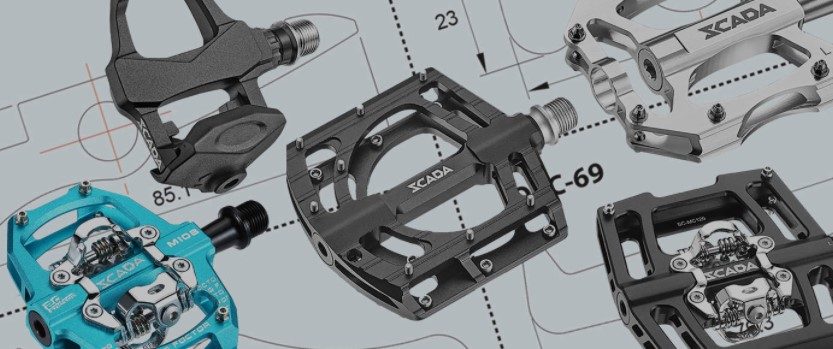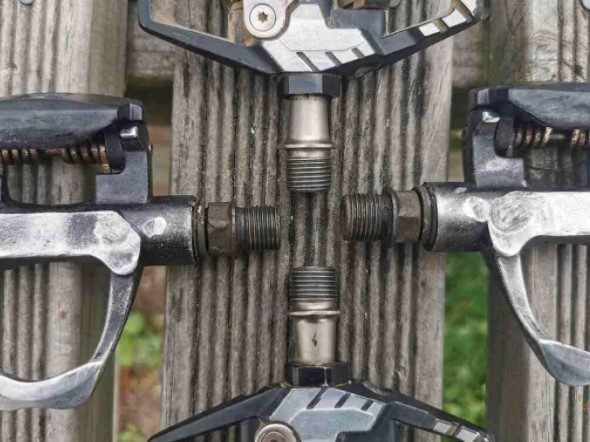The type and size of a bike’s pedals determine how convenient your ride will be. And once you get the right idea on what are the different types of bike pedal thread size, you can decide the type best for your riding style.
The options when it comes to bike pedal thread size are not as extensive as people think. Although there are many options available, there are just two major types of bike pedal thread sizes. These are ½” and 9/16″. While you are likely to see less of the ½” pedal, the 9/16″ pedal is a relatively popular option, and you are likely to see it almost every day.
Beyond these major types, there are also other variations.
However, selecting which pedal thread size and type is suitable for your bicycle can be tricky, if not challenging. This is mainly because of the large number of bicycle pedals available to riders.
In this comprehensive guide, I’ll discuss everything you need to know about bike pedal thread sizes. This way, you’ll get to know the perfect fit for you and make the right buying decision. So, let’s get to it!
What Is Bike Pedal Thread And How Does It Work?
A bike pedal thread is the thread within the screw that attaches the pedal with the bottom bracket. The right and left side are words you must be familiar with if you own a bicycle. But unlike what you know, bike pedal threads have nothing in common with neither the right side nor the left side. They are entirely different.
The left-hand thread comes with the left side pedal, meaning that its installation occurs counterclockwise and removes clockwise.
On the other hand, the right-hand thread comes with the right side pedal, with the installation occurring clockwise and removal counterclockwise.

How Does Bike Pedal Thread Work?
A little history lesson might be extremely useful to know how these tools work. Before the period they designed airplanes, the Wright Brothers had developed how bike pedal threads work.
The process is quite simple. While the right side comes with a normal thread, the left side, on the other hand, has a reverse thread.
Perhaps it is still unclear why the Wright Brothers chose to design the threads this way; the reason is not too distant to infer. They were designed to work in this manner so that while in motion, the pedals will not move in the direction of loosening. Instead, their movements will be towards tightening.
Thus, the pedals can be prevented from coming loose as you move from one place to another. But if they haven’t designed these tools to work this way, there’s no way you can be getting all those cycling fun and bliss you are enjoying today.
What Are The Different Types Of Bike Pedal Thread Size?
There are basically two major types of bike pedal thread- 1/2″ and 9/16″ x 20 TPI thread. Nevertheless, bike pedal thread size is not only the tricky thing about bike pedal threads; their types are also another big deal to put up with.
There are myriads of types, and if you do not know how to get your head around them in the first instance, the chances are that you will make the wrong choice. You might just as well choose to turn a regular bike into an e-bike.

It is crucial that you know the features and specs of each of these sizes to know which of them will work well with your bicycle. Also, your bike type is important. For instance, there are some pedal thread sizes that are suitable for specific bike brands.
Below are some of the types of bike pedal thread sizes that you can choose for your bike. The list will begin from the most common of them all.
i. 9/16″ × 20 TPI (thread per inch)
Known for being the thread size that most producers use for their pedals, the 9/16″ bike pedal thread size is the most popular type on the market recently. It has twenty threads per inch, and you are likely to find it on invariably every modern adult bike there is.
Usually, you will find it on road and mountain bikes. Most big brands such as Giant, Specialized, Trek, and several others have this thread size. Therefore, if your bike belongs to any of these categories, the 9/16″ is your best bet.
Besides, if it’s an adult bike, you need not search any longer. What you are looking at is the 9/16″ bike pedal thread size.
ii. ½” × 20 TPI (thread per inch)
Coming second in the list, this bike pedal thread size is less common than the former. However, this does not entirely rule out the fact that you will not find bikes of 1/2″ thread size in the market today. In fact, there are still bike manufacturers who produce such bikes. They are only less common.
More often than not, the only bikes you are likely to find with a 1/2″ x 20 TPI pedal thread size are less-costly adult cruiser bikes, BMX bikes, and kids’ bikes. Suppose you have one of these bikes at your disposal. In that case, there is a high probability it has the ½” pedal thread size.
Like the 9/16″ pedal thread size, this one also has twenty threads per inch.
iii. 55″ × 20.32 TPI (thread per inch)
When describing this bike pedal thread size, qualifiers such as old and outdated may be the right words to use. This is because you hardly find them in the market in recent times. Even bike manufacturers haven’t used this type of pedal thread size for a long time.
This bike pedal thread size owes its origin to the old-style French bicycles. This is as far back as the time when the French decided to choose a bike size of their own.
But as time changed and bikes began to be exported and imported, this thread size soon became outdated. Instead of making bikes with this pedal thread size, they decided to switch to the two bike pedal thread sizes prevalent today.
The chances are that this is your bike’s pedal thread size if you have an old French bike. To be sure that it is this type of thread size, you will find it labeled G and D. These letters mean Gauche and Droite in French, respectively. And by interpretation, left and right in English, respectively.
Bike Pedal Thread Size Comparison- 9/16″ vs 1/2″
Regarding which bike pedal thread size is the most efficient between the two, there is no significant difference in their performance. Both are quite efficient and perform optimally. In a more relatable term, it means that how smooth your ride is, does not depend on your bike’s pedal thread size.
Concerning which terrain is the most suitable for either of these pedal thread sizes, the good news is that both thread sizes can handle any terrain without damage. The only difference is that they are of different thread sizes and thus, do not fit every pedal.
How Do I Know My Bike Pedal Thread Size?
Knowing what size your bike pedal thread is shouldn’t be a big deal as long as you have been able to determine the bike type. There are several ways you can find out the size of your bike’s pedal thread.
Although you need very little knowledge, all you need to do is adopt a number of approaches, and it all comes in handy. Consider the following hacks and tricks to know your bike pedal thread size.

1. Check the Bike’s Cranks
This is perhaps the easiest way to determine your bike’s pedal thread size. The manufacturers have done the job; all you need to do is take a look. The cranks on your bike have a lot of information to tell you about what size your bike pedal thread is.
Suppose your bike’s cranks are designed with two distinct crank arms and three sections with a spindle passing through the frame. In that case, the pedal thread size is the common type – the 9/16″ × 20 TPI.
On the other hand, the size will be the less common type – ½” × 20 TPI if your bike comes with only a piece of metal. Usually, this metal goes through the bicycle as a single piece.
2. Get an Accurate Measurement of the Thread Size
This is another way to find out what size your pedal thread is. Although a little trickier than the former, it can offer you an accurate result. You might be wondering how to go about this?
The solution is not far-fetched. All you need to do is to measure the thread width.
If you have a set of calipers at your disposal, then it can only get better. This is the right tool because the thread sizes are often pretty similar. Also, it will give you a perfect measurement.
Alternatively, you can use a standard ruler to take the measurement. However, there’s no guarantee you will achieve an accurate result.
3. Visit a Local Bike Shop
If, after trying the two tricks above, you still haven’t figured out what size your bike’s pedal thread size is, you need to take the next step. The next step involves taking it to a local bike shop. Whatever you want, they should be kind enough to do them for you, including telling you your bike pedal thread size and helping you with a new set of pedals, if need be.
It is worth mentioning that if all it takes to replace all pedal threads were the same tools or if all of them were of the same sizes, you will have no trouble selecting the one that fits your bicycle perfectly. But with variation comes greater task.
Wrap Up
The fun, bliss, and chills of cycling along the mountains or moving from one street to another will never feel complete without the right bike pedal thread size. But it is tricky knowing which thread size type your bike is, but if you can determine whether it is the 9/16″ or the ½” size, your problems are minor.
Similarly, you can check your bike’s cranks or get an accurate measurement of the thread size to know what thread size your bike is. If it’s not easy to determine, the local bike shop may be the ideal alternative.

